
Large, narrowly conical, semi-evergreen tree. Bark grey, fissured. Young and lower shoots sometimes angled and occasionally others. Buds sticky and smelling of balsam. New growth reddish brown. Leaf blade to 16 cm long, 12 cm wide, ovate, glossy dark green above, whitish green below, the base mostly tapering, not rounded. Midrib and veins pinkish, especially on the upper surface when young. Margin finely toothed, base more or less cordate without glands, tip long-pointed. Leaf stalk to 10 cm long, more or less cylindrical.
SW China
Descriptions of true P. yunnanensis refer to leaves that are diamond-shaped to widest above the middle, the leaf stalks always less than 2 cm long, quite unlike Australian trees at present grown under this name which have leaf stalks generally at least 5 cm long. Most specimens in Australia are probably the result of hybridisation. Some crosses were made in 1959 at Yarralumla Nursery, Canberra between P. yunnanensis and P. deltoides subsp. monilifera. Four selections from these trials were named 'Gundaroo', 'Yarralumla', 'Brindabella' and 'Gininderra'; the cultivar now called 'Monyun' is almost certainly one of these. A separate clone from a 1960 seedling of P. deltoides of Texas provenance was also produced a year later and given the name 'Weetangera'. Other P. yunnanensis crosses were produced, mainly with P. deltoides, in later years. Trees in Melbourne with long petioles and orangish bark when young agree well with the general characters of 'Gundaroo'.
This tree is now commonly planted in Australia. Herbarium specimens from the nursery trade in Victoria appear as early as 1941 and this (or an extremely similar) long-petioled clone is also widely grown in New Zealand.
There is one male clone of true P. yunnanensis planted in Canberra and found occasionally in New South Wales; it is an old introduction-at least before 1940 and appears identical with the clone used in streets and roadsides in Kunming, China to this day. In about 1980 Dr C.W.S. Kraayenoord of the Plant Materials Research Centre, Palmerston North, New Zealand, imported seed of the species from China and 2 or 3 clones obtained from him were introduced to Australia although not distributed and slightly different from the established male clone.
Widely grown for its quick growth, virtually persistent leaves, resistance to drought and cold and well suited to Australian conditions.
Long leaf stalk; pinkish veins and new growth; leaves held almost through winter.
Specimens VIC: Mt Martha ('Seawinds Gardens'); Richmond (Gosh's Paddock, round the oval).
Sykes (1988).
P. szechuanica var. tibetica is occasionally offered; a taxon of obscure origin that also has long, pink leaf stalks but is hairy on the midrib and main veins below and on the young leaf stalks.
Source: (1997). Salicaceae. In: . Horticultural Flora of South-eastern Australia. Volume 2. Flowering plants. Dicotyledons. Part 1. The identification of garden and cultivated plants. University of New South Wales Press.
